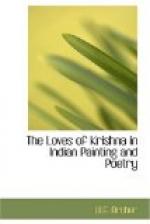Note 9, p. 29.
Krishna’s constant alterations of role, appearing sometimes as God but more often as boy or man, have been commented on by Isherwood and Prabhavananda in connection with Arjuna’s dilemma in the Mahabharata. ’Krishna is the divine incarnation of Vishnu, Arjuna’s chosen deity. Arjuna knows this—yet, by a merciful ignorance, he sometimes forgets. Indeed, it is Krishna who makes him forget, since no ordinary man could bear the strain of constant companionship with God. After the vision of Krishna’s divine aspect, Arjuna is appalled by the realization that he has been treating the Lord of the universe as ‘friend and fellow-mortal.’ He humbly begs Krishna’s pardon, but his awe soon leaves him. Again, he has forgotten. We may infer the same relationship between Jesus and his disciples after the vision of the transfiguration.’ (The Song of God, Bhagavad-Gita, 29-30).
Note 10, p. 33.
Although part of the supreme Trinity, Brahma was often treated in literature as an ordinary god who ambled gently about the world, was often rather absent-minded, sometimes behaved as if he were a priest, and was prone, as on the present occasion, to act a trifle misguidedly.
Note 12, p. 40.
The scene is illustrated in two Kangra and Guler paintings (Archer, Indian Painting in the Punjab Hills, Figs. 10 and 23).
Note 12, p. 58.
Pragjyotisha—a city situated in the east, in Kamarupa on the borders of Assam. According to the Vishnu Purana (Wilson, 582), its environs were defended by ’nooses, constructed by the demon Mura (Naraka’s ally), the edges of which were as sharp as razors.’ Mura had seven thousand sons (not seven, as stated in the Bhagavata). All, however, were ’burnt like moths with the flame of the edge of Krishna’s discus.’
Note 13, p. 67.
Basham (op. cit., 305) points out that elements in the Krishna story such as the destruction of the Yadavas and the death of the god are ’quite un-Indian in their tragic character. The themes of the drunken brawl leading to a general slaughter, of the hero slain by an arrow piercing his one vulnerable spot, and of the great city engulfed by the sea, are well-known in European epic literature, but do not occur elsewhere in that of India and are not hinted at in the Vedas. The concept of the dying god, so widespread in the ancient Near East, is found nowhere else in Indian mythology.’
It is unfortunate that Krishna’s reasons for destroying the Yadava race are nowhere made very clear. The affront to the Brahmans is the immediate occasion for the slaughter but hardly its actual cause; and, if it is argued that the Yadavas must first be destroyed in order to render Krishna’s withdrawal from the world complete, we must then assume that the Yadavas are in some mysterious way essential parts of Krishna himself. Such a status, however, does not seem to be claimed for them and none of the texts suggest that this is so. The slaughter, therefore, remains an enigma.




